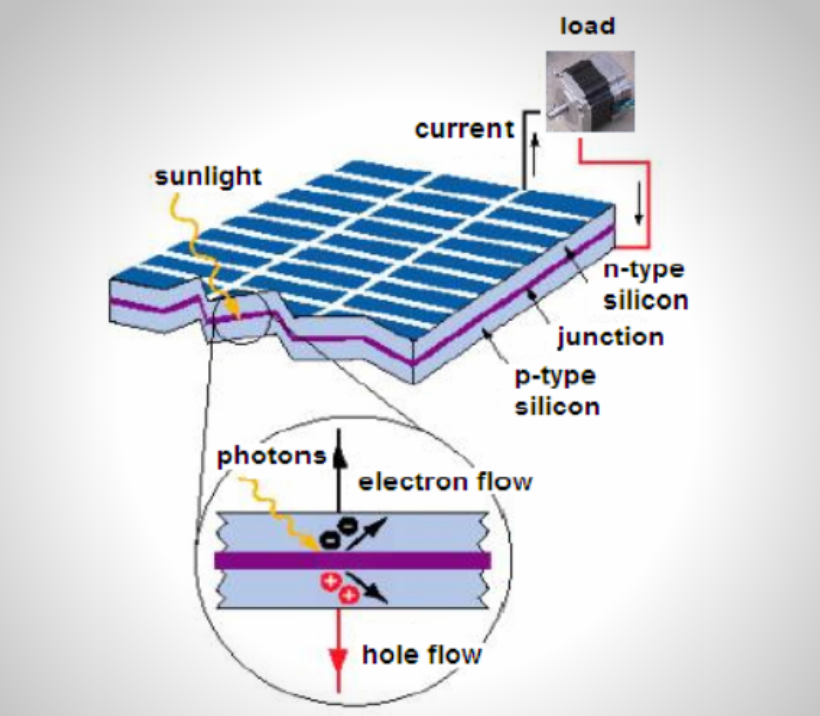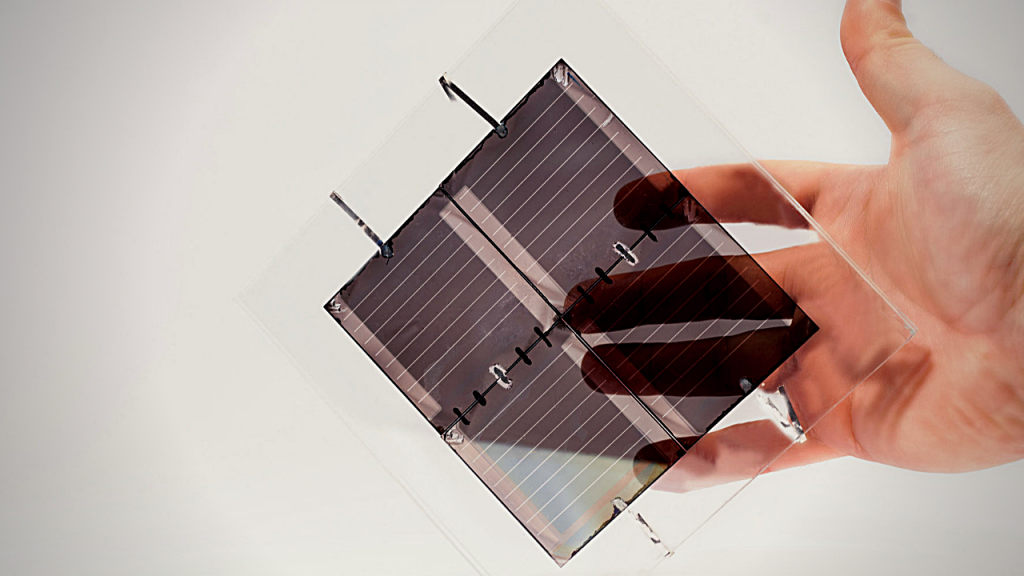In today’s market, solar panel efficiency is between 16-23% efficient. This is based on the National Renewable Energy Laboratory (NREL) Champion Photovoltaic Module Efficiency Chart [1]

That’s way up before solar panels become a mainstay for American Industry. Back in the 1950s, Hoffman Electronics introduced the first photovoltaic cell (PV Cell), which had only 2% efficiency, and the cost to make one of those cells was a whopping $1785/W. From 1950 – the 1960s, the company produced solar cells that produced up to 14% efficiencies for ten years. (history-of-PV-technology, n.d.)
At the break of the 21st winning combination, the world has stepped into the renewable energy future, where climate change solutions are becoming more aware and being adopted worldwide.
The graphs below show the National Renewable Energy Laboratory (NREL) research timeline on solar cell energy conversion efficiencies since 1976.[2]

What is a Solar Cell
A solar cell is made of various semiconductor materials similar to computer chips made of silicon. Computer. Semiconductors have conductivity between conductors, generally known as metals, and between insulators, such as ceramic and glass. They are typically made of pure elements such as silicon or germanium. They are helpful because the deliberate addition of impurities can easily manipulate their behaviors. By adding impurities, otherwise known as doping, you can adjust the number of holes and electrons in the semiconductor. A semiconductor with excess holes is called a P-type semiconductor, and one with extra electrons is called an N-type semiconductor. The combination of both p-type and n-type semiconductors is called a PN junction. So, when photons of light hit the PN junction semiconductor or silicon solar cells, the energy is absorbed and enables the electron to flow through the materials in the solar cell. This flow of electrons through the solar cell can be extracted as electricity through the grid lines of the solar cell.

What is Solar Panel
A solar panel, otherwise known as a solar panel module, is a collection of solar cells mounted on a frame prepared for Solar Energy Installation. The collection of these modules or solar panels that is wired together is called an array, and the array, when it is mounted to a rooftop or installed in an open area, is called a solar energy system. Most solar panels from rooftop solar installations have 60 cells connected in series. At the same time, standard commercial solar panels are made of 72 cells.
Solar Panel Efficiency
Solar Panel efficiency is determined by a portion of sunlight that falls on the solar panel, converted into usable electricity by solar cells in the solar panels. It is important to note that improving solar panel efficiency aims to make solar costs competitive compared to the other forms of energy.
The Shockley – Queisser Limit spells out the maximum theoretical efficiency of a solar cell made by a single PN junction. This limit was first calculated by William Shockley and Hans Queisser and based on the calculation. They determined that the maximum solar conversion would be tapped at 33.7% based on assuming a single PN junction with a bandgap of 1.4 Ev. In solid-state physics, the bandgap is also called the energy gap, where no electronic states exist.
Factors that affect Solar Cell Efficiency
A couple of factors affect the conversion of high-efficiency solar panels because not all the sunlight that hits the solar panels / PV cells is converted into electricity. Somewhat a sizable amount of it is lost.
Wavelength – Sunlight is composed of photos, and these photos have a wide range of energies from ultraviolet, to the visible spectrum, to infrared. The photons in the visible range are the ones we’re able to observe. So when photos of sunlight strike the surface of the solar panels, few photons are reflected from the surface, few are converted into heat, and the remaining % of photons are converted to voltage in the solar cell through a process known as the “photovoltaic effect.” The photons strike the surface, called the p-n junction, which causes a movement of electrons to the n-type side and holes to the p-type side of the junction, resulting in the creation of charge carriers and, as a result, a result electric current.
Recombination – Recombination is another factor that affects Solar cell efficiency. When a photon hits the p-n junction, there is a good possibility for a charge carrier to be created in the form of a negatively charged electron. At the same time, another photon could create a positively charged carrier. When there is a movement of electrons to the n-type side and encounters a hole or vice versa, there is a good possibility for them to recombine and, as a result, cancel out any of their contributions to the electric current generation. Direct recombination is one of the most significant factors that reverse electric generation in a solar cell and, thereby, is one of the limiting factors that affect efficiency. Indirect recombination is when a hole or an electron interacts with an impurity, a defect in the cell structure, making it easier to recombine and release their energy as heat.
Temperature – A solar cell works best at low surface cell temperature. As the surface temperature of the solar panel increases, the solar cell properties start to change, and there is a slight increase in current (I). Still, the voltage (V) decreases significantly. As a result, it causes the panels’ power output to drop. So during summertime, the cell temperature on the panel increases and results in below peak output, whereas in winter, the solar power output is performing in peaks.
Critical Factors that Affecting High-Efficiency Solar Cells [3]
Reflection – Reflection affects the output of the solar panel efficiency. It’s a well-known fact that the reflection of light is essentially uncaptured energy where the photons bounce off the solar cell’s surface. According to the Department of Energy [4], silicon cells not treated with impurities have almost 30 % of the incident light bounce off the surface. As a result, various anti-reflection coatings have been developed to raise the efficiency of solar cells. The Quarter-wavelength AR coating is one of the most common anti-reflection coatings used in the most efficient solar cells. But their effectiveness depends mainly on wavelength and incident angle.
Top 5 Most Efficient Solar Panels in Commercial Use.
SunPower – 420 W Residential AC Solar Panel [5]
SunPower’s new Maxeon Gen 5 Solar Cell is 65% larger than any solar cell in its previous generation. The Sunpower 420W has a solar cell efficiency of 22.5% and has 66 cells arranged in the solar panel to produce a maximum continuous output power of 349W.
LG Neon – 380 W High Power AC Solar Panel Solar Panel [6]
LG NeON® ACe is the new NeON® R series Solar Cell designed for high-power output, making it efficient even in limited space. The 380 W LG Solar Panel has a solar cell efficiency of 22% and has 60 monocrystalline cells arranged in a solar panel to produce a maximum continuous output power of 282W.
REC Alpha – 380W AlphaX Power Solar Panel [7]
REC Alpha Series is built with the new REC heterojunction cell technology with 120 half-cut cells connected in series. The 380 W REC Solar Panel has a solar cell efficiency of 21.7 % and produces a maximum continuous output power of 289W.
Panasonic – 370W EverVolt Solar Panel [8]
Panasonic EverVolt Series is a superior solar panel that utilizes heterojunction cell technology with half-cut cells that minimize electron loss and maximize conversion efficiency. The 370W Panasonic solar panel has a solar cell efficiency of 21.2%, which produces a maximum continuous output power of 277.5W.
Jinko Modules – 475W Eagle Solar Panel [9]
The Jinko Eagle Module series is a ribbon-based module that utilizes TR technology, eliminating cell gaps to increase module efficiency and power. It has half-cut cells designed to deliver ultra-high power in a small footprint. The 475W Jinko Eagle series module has a solar cell efficiency of 21.16% and a maximum continuous output power of 353W.
Latest Update on breakthroughs
Thin Film Solar Cells

The Thin-film solar cells are made of thin layers of semiconductor material, such as cadmium telluride or copper indium gallium diselenide. The thickness of these cell layers is only a few micrometers. The advantage of these films is their flexibility and lightweight.
III- V Solar Cells

These solar cells are made from III-IV solar cells, mainly from Group III-V of the periodic table. Group III of the periodic table consists of gallium and indium, whereas Group V is mostly arsenic and antimony. These solar cells are more expensive to manufacture than other technologies, but their advantage is that they can convert the amount of sunlight with high efficiency.
Organic photovoltaic Solar cells
OPV is an emerging Solar Panel (PV) technology with a certified 18.2 % cell efficiency and a ten-year performance lifetime. This technology is particularly appealing to the building-integrated PV market. The OPV cells are made of organic carbon compounds, are about half as efficient as crystalline silicon cells, and have shorter operating lifetimes.
Pervovskite Solar Cell

A perovskite solar cell is a solar cell that is made of perovskite-structured compounds. These compounds are an organic-inorganic compound mix that’s generally available in nature. The Solar Cells created from perovskite have their efficiencies from 3.5% in 2009 to 25.5 % in 2021, which is remarkable in such a short period. Their power conversion efficiency has rapidly exceeded that of any thin-film technology, except for III-V. But don’t expect solar panels made of perovskite compounds in the next few years, as these panels’ long-term stability, fabrication, and manufacturability need to work out to ensure mass-market adoption.
Final Thoughts
Although Solar panel efficiency is considered one of the most critical indicators, it’s not the be-all-end-all when selecting solar panels because the slightly more efficient panel may not equate to a better quality. After all, the solar panel manufacturers’ quality relates to actual-world performance, reliability, manufacturing service, and other warranty conditions.

